Fall of Singapore - papers of Charles Laurie Price, part 4
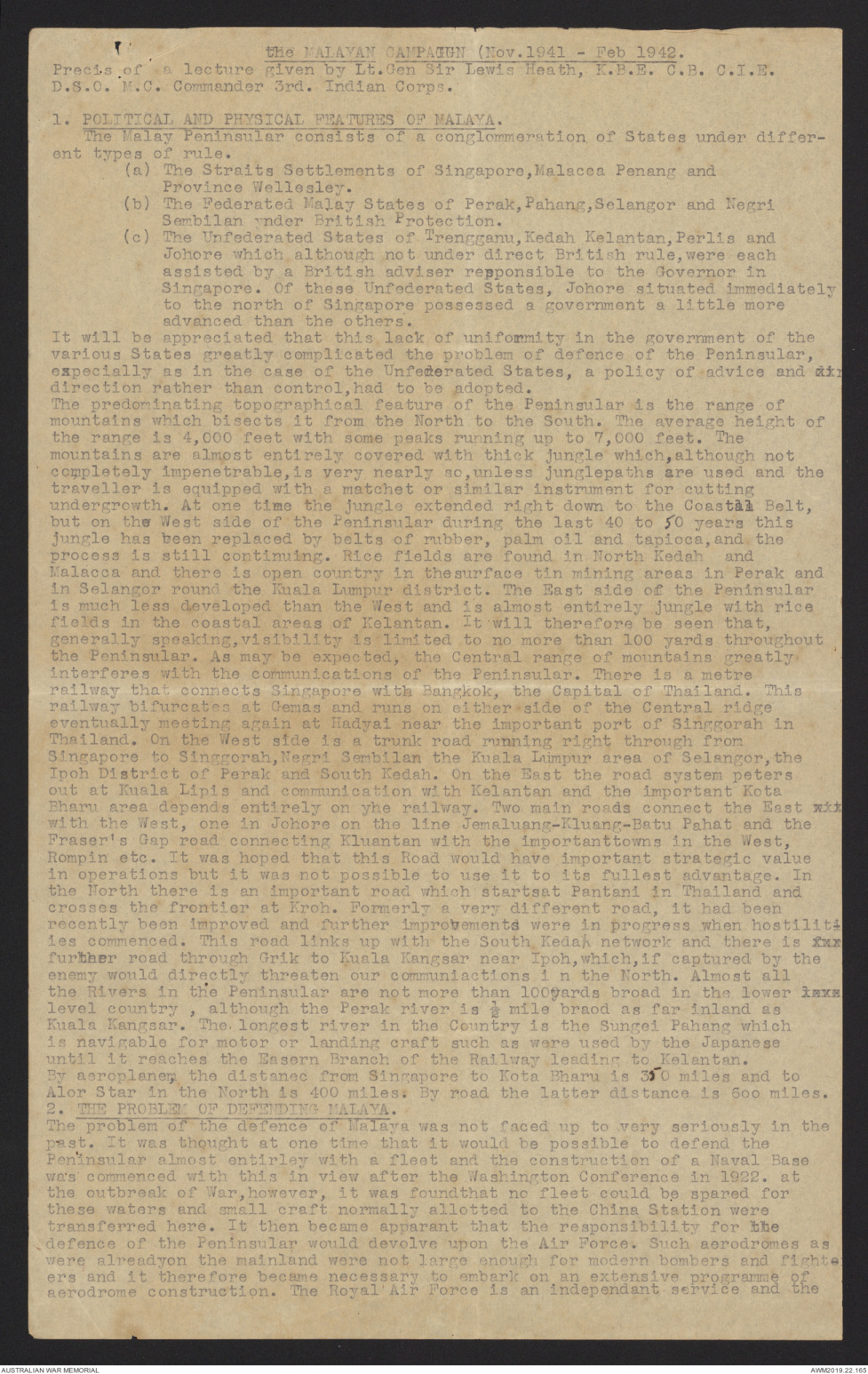
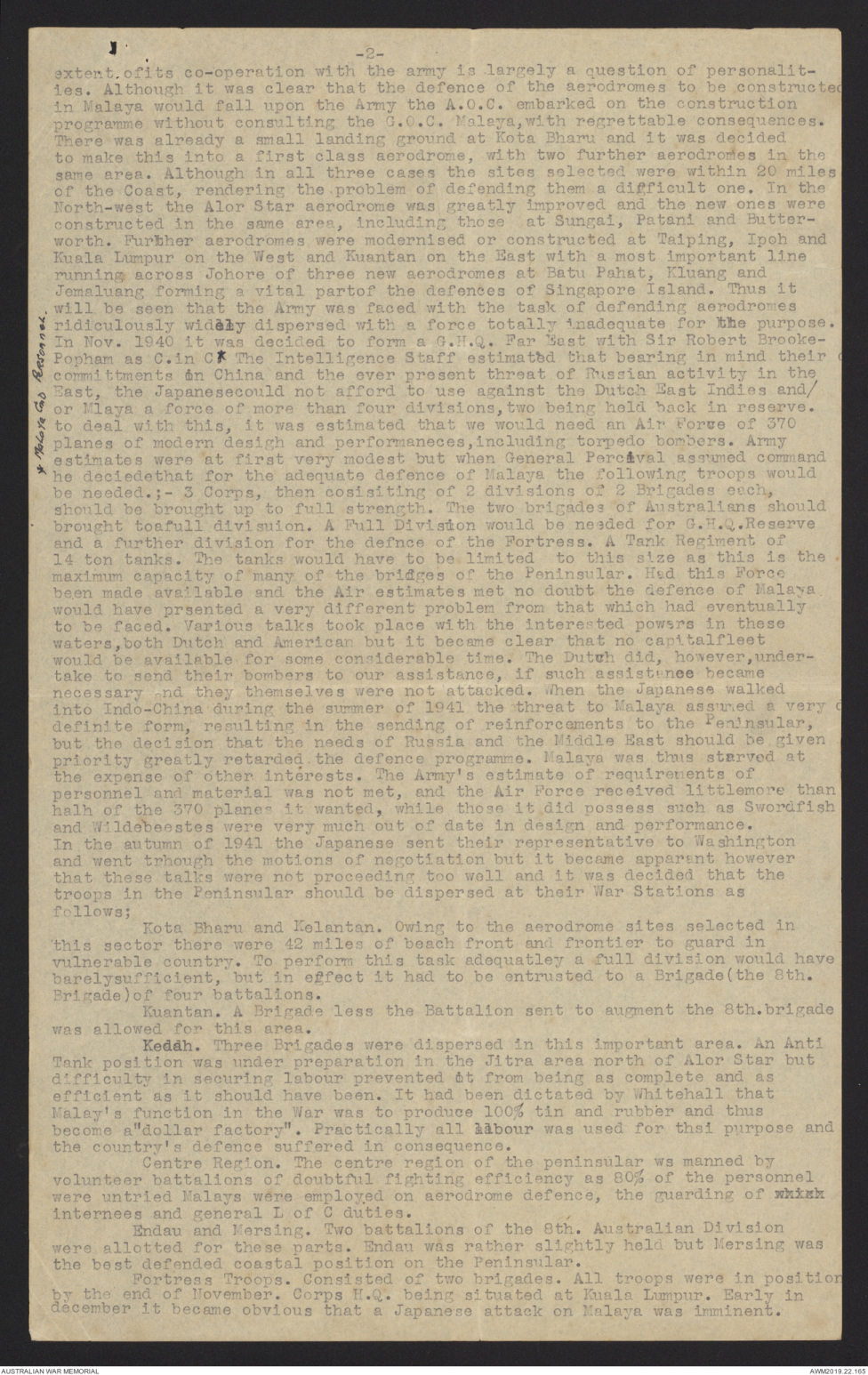
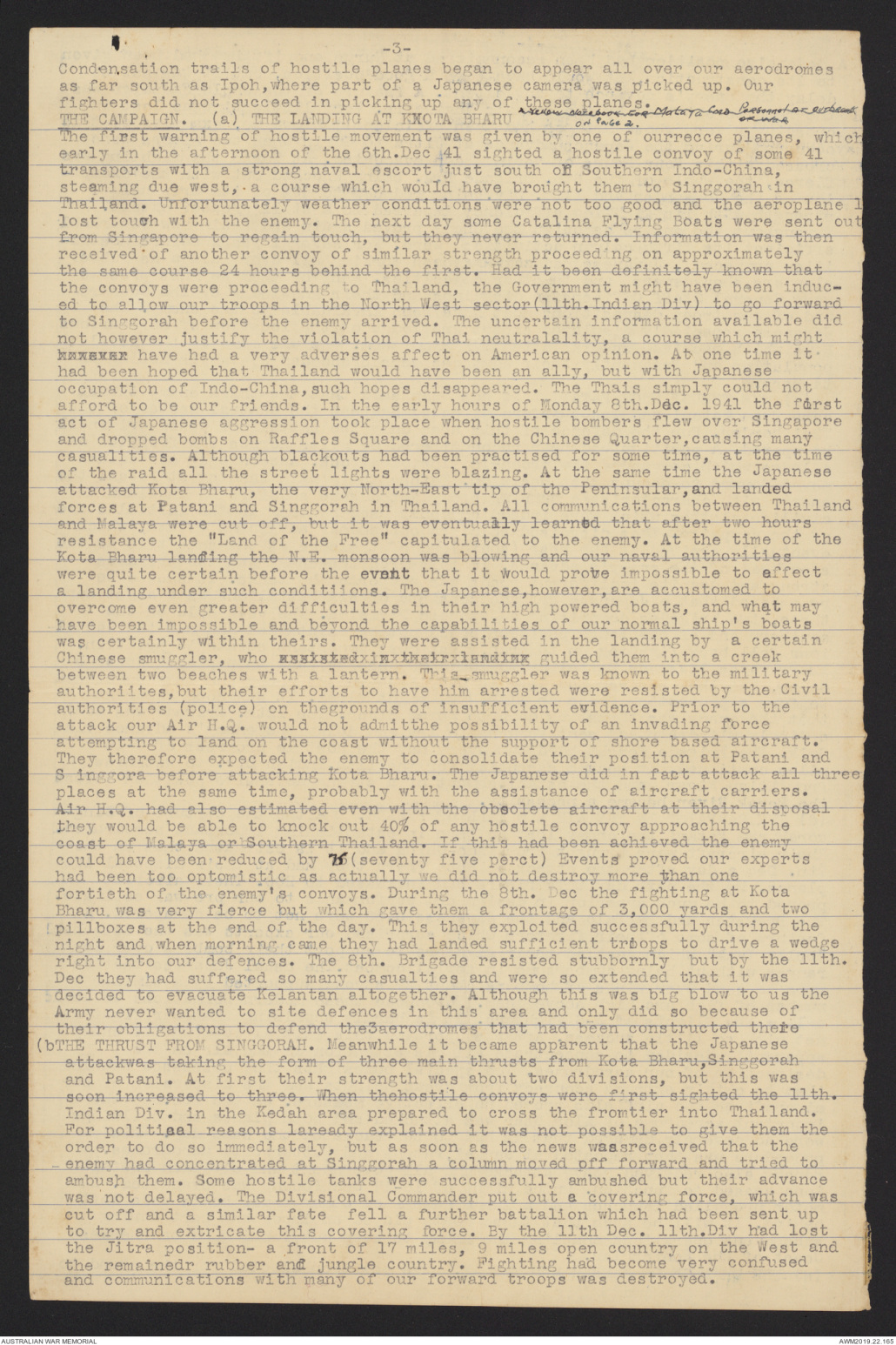
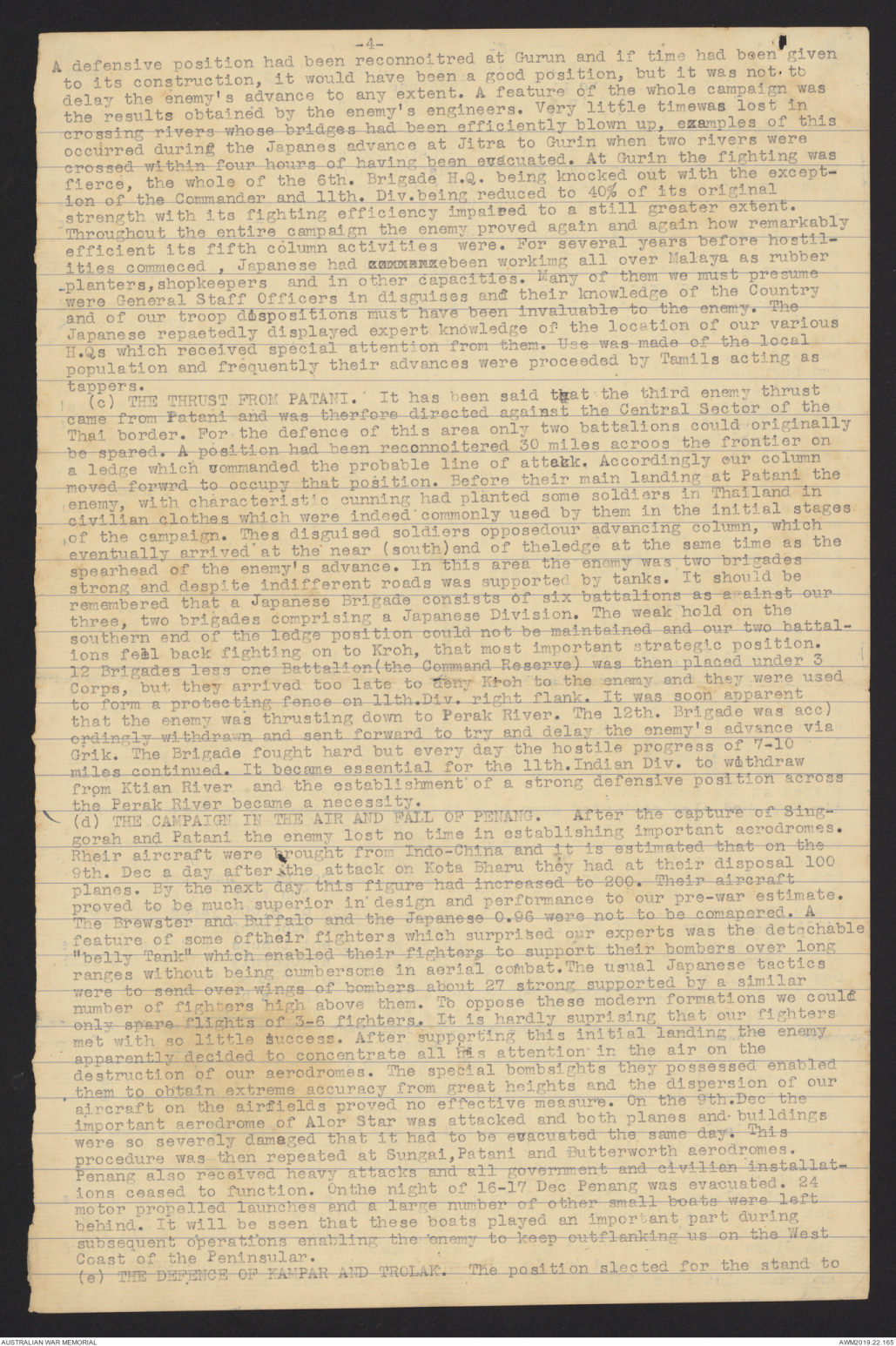
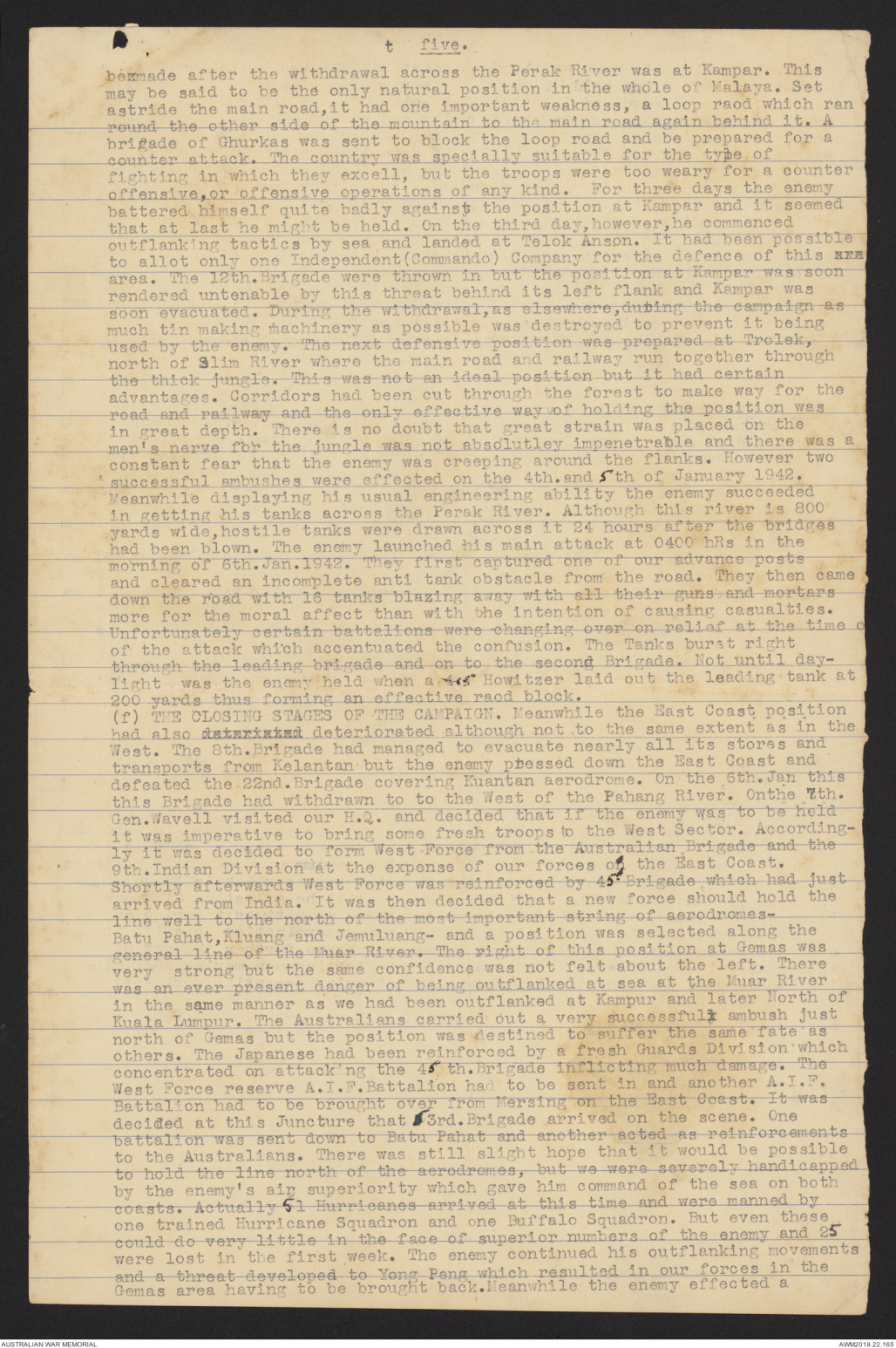
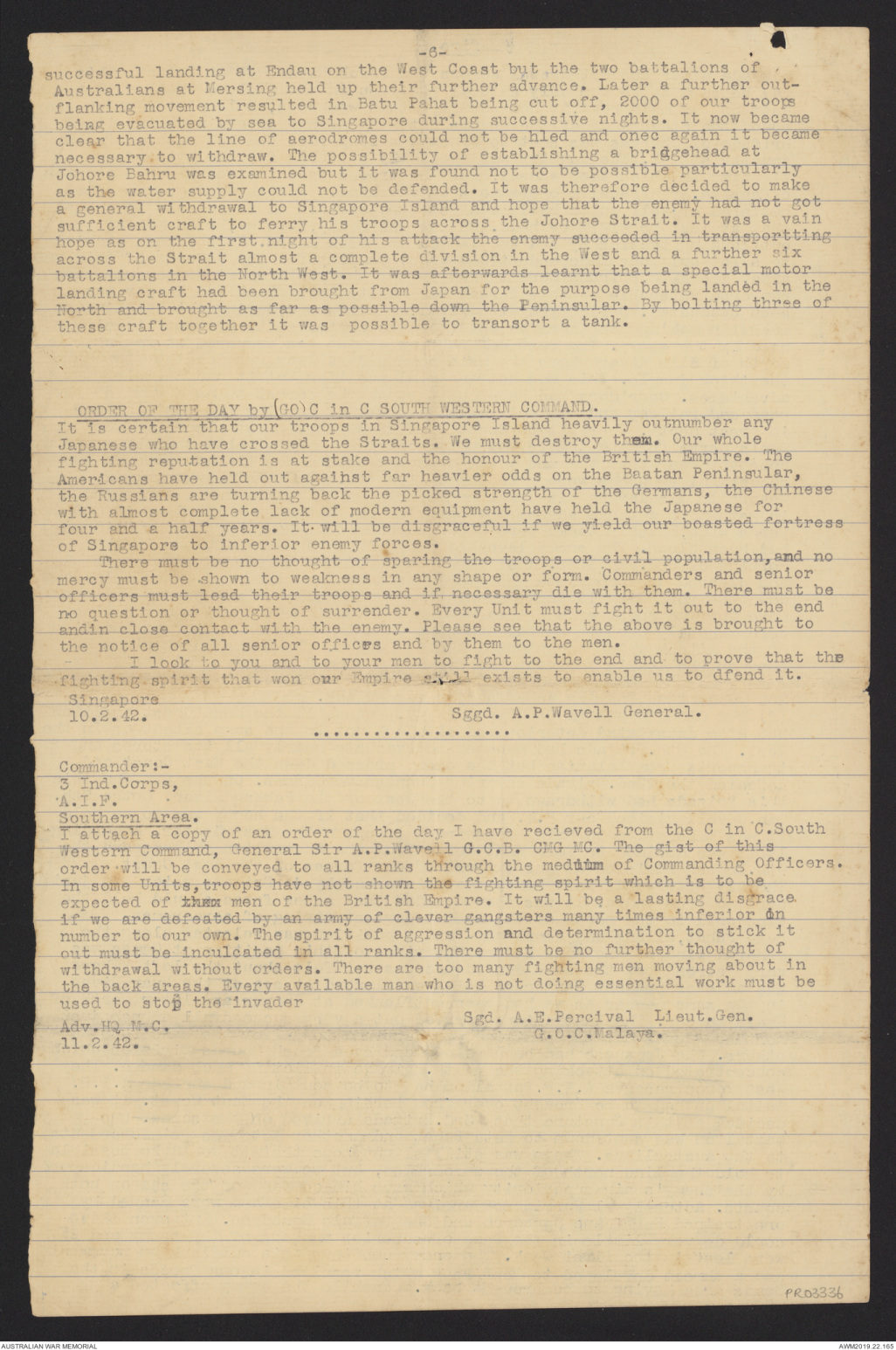
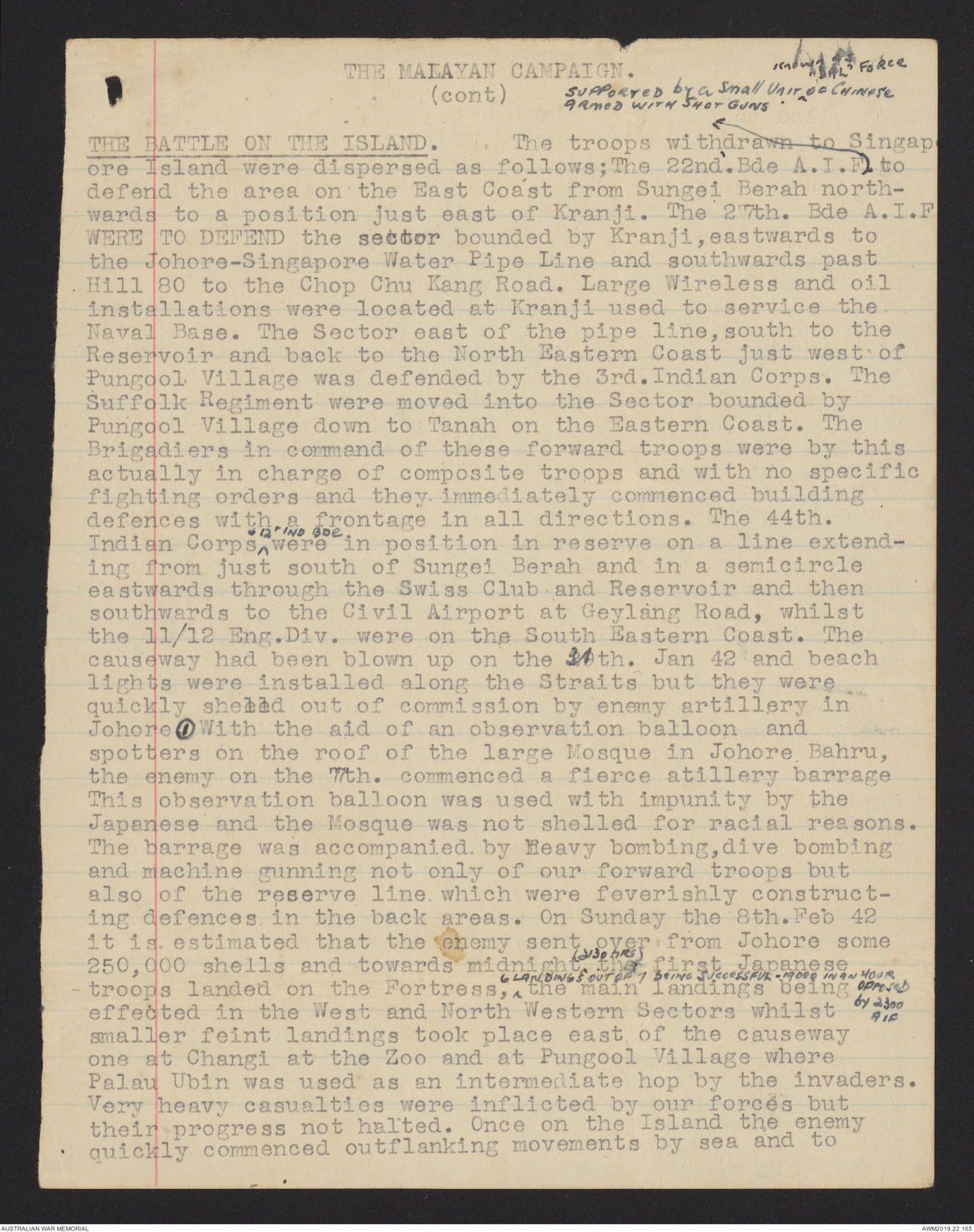
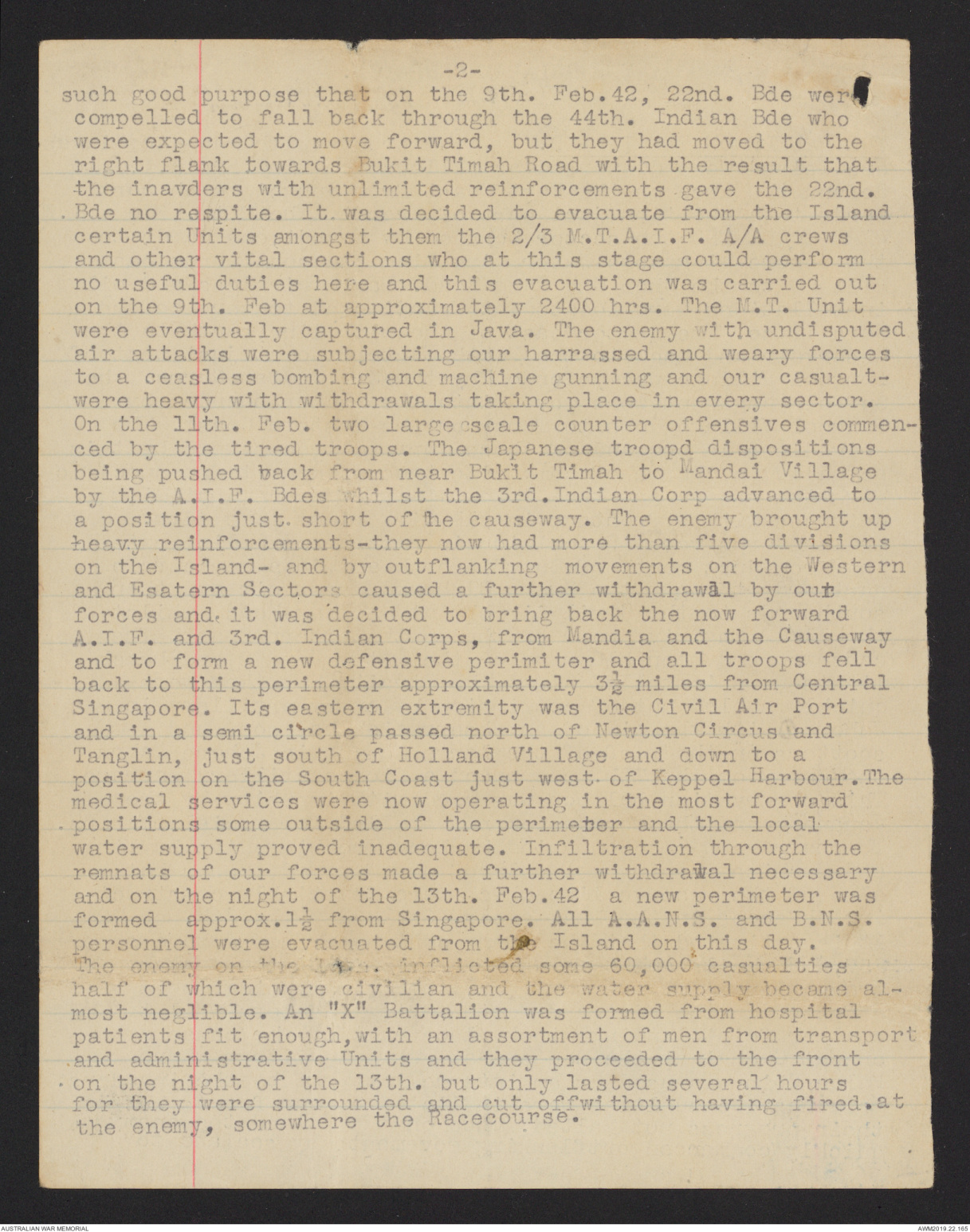
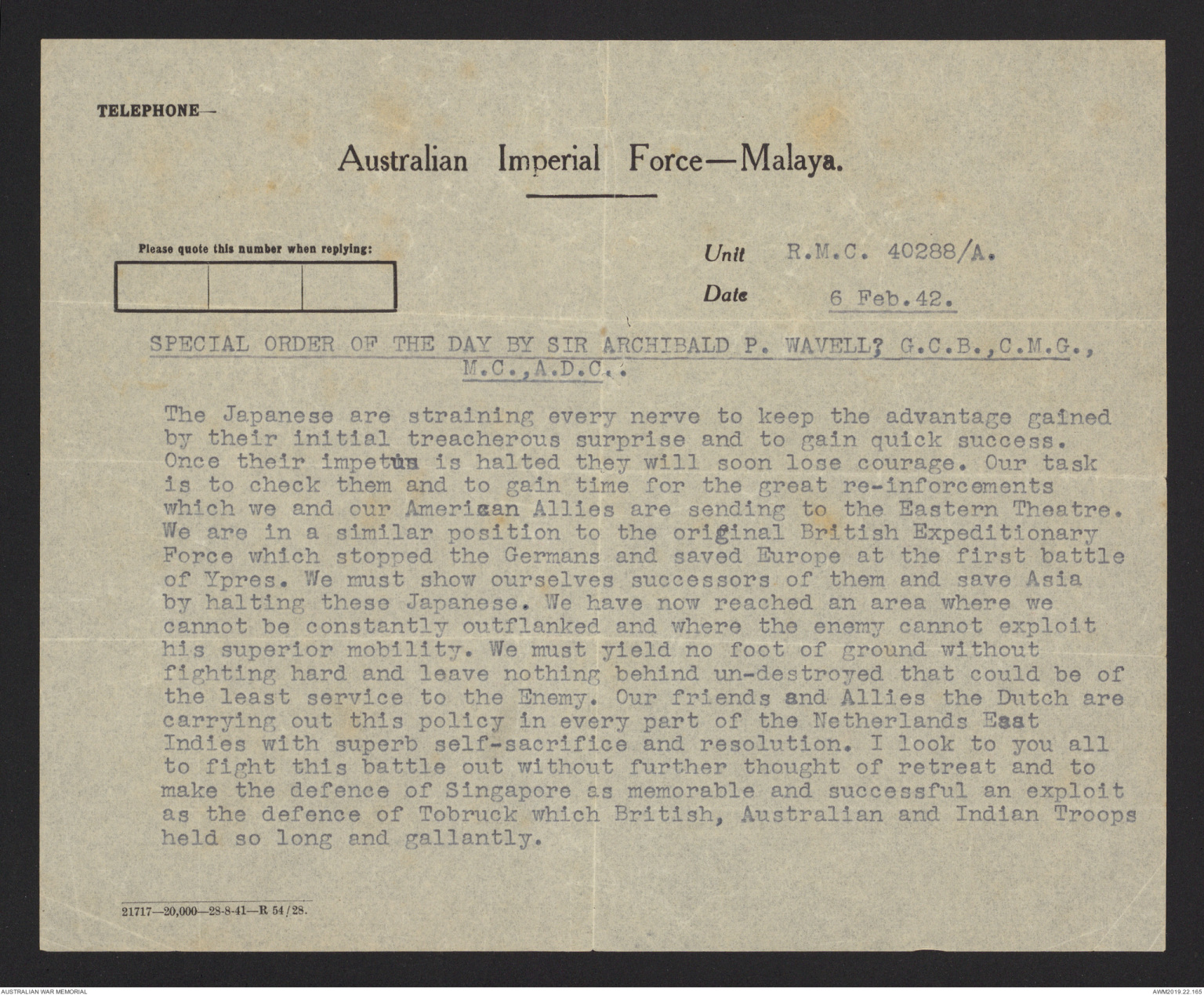
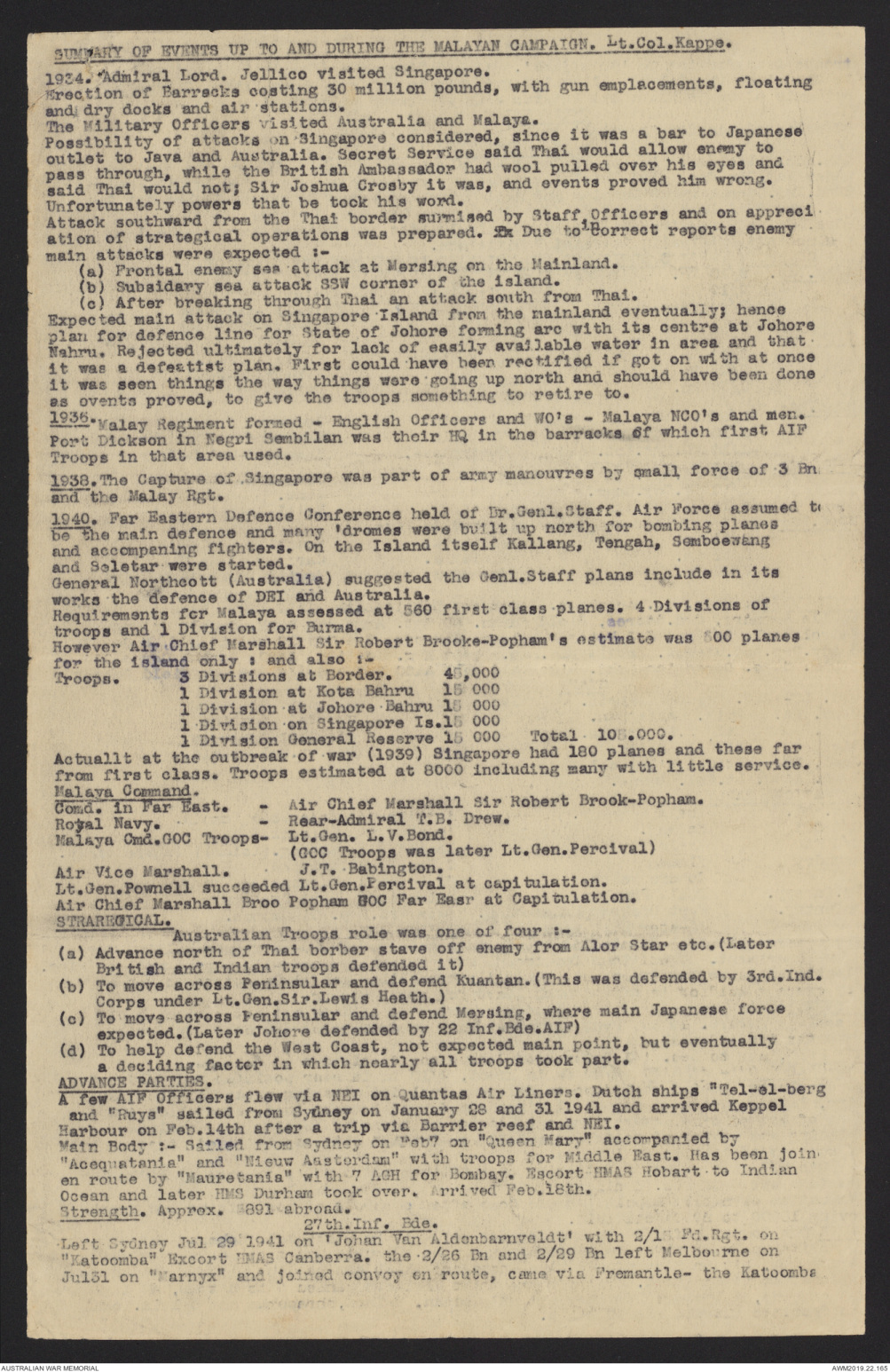

the MALAYAN CAMPAGIGN (Nov.1941 - Feb 1942.
Precis of a lecture given by Lt. Gen Sir Lewis Heath, K.B.E. C.B. C.I.E.
D.S.O. M.C. Commander 3rd. Indian Corps.
1. POLITICAL AND PHYSICAL FEATURES OF MALAYA.
The Malay Peninsular consists of a conglommeration of States under differ-
ent types of rule.
(a) The Straits Settlements of Singapore, Malacca Penang and
Province Wellesley.
(b) The Federated Malay States of Perak, Pahang, Selangor and Negri
Sembilan under British Protection.
(c) The Unfederated States of Trengganu, Kedah Kelantan, Perlis and
Johore which although not under direct British rule, were each
assisted by a British adviser responsible to the Governor in
Singapore. Of these Unfederated States, Johore situated immediately
to the north of Singapore possessed a government a little more
advanced than the others.
It will be appreciated that this lack of uniformity in the government of the
various States greatly complicated the problem of defence of the Peninsular,
especially as in the case of the Unfederated States, a policy of advice and dir
direction rather than control, had to be adopted.
The predominating topographical feature of the Peninsular is the range of
mountains which bisects it from the North to the South. The average height of
the range is 4,000 feet with some peaks running up to 7,000 feet. The
mountains are almost entirely covered with thick jungle which, although not
completely impenetrable, is very nearly so, unless jungle paths are used and the
traveller is equipped with a matchet or similar instrument for cutting
undergrowth. At one time the jungle extended right down to the Coastal Belt,
but on the West side of the Peninsular during the last 40 to 50 years this
jungle has been replaced by belts of rubber, palm oil and tapioca, and the
process is still continuing. Rice fields are found in North Kedah and
Malacca and there is open country in the surface tin mining areas in Perak and
in Selangor round the Kuala Lumpur district. The East side of the Peninsular
is much less developed than the West and is almost entirely jungle with rice
fields in the coastal areas of Kelantan. It will therefore be seen that,
generally speaking, visibility is limited to no more than 100 yards throughout
the Peninsular. As may be expected, the Central range of mountains greatly
interferes with the communications of the Peninsular. There is a metre
railway that connects Singapore with Bangkok, the Capital of Thailand. This
railway bifurcates at Gemas and runs on either side of the Central ridge
eventually meeting again at Hadyai near the important port of Singgorah in
Thailand. On the West side is a trunk road running right through from
Singapore to Singgorah, Negri Sembilan the Kuala Lumpur area of Selangor, the
Ipoh District of Perak and South Kedah. On the East the road system peters
out at Kuala Lipis and communication with Kelantan and the important Kota
Bharu area depends entirely on the railway. Two main roads connect the East xxx
with the West, one in Johore on the line Jemaluang-Kluang-Batu Pahat and the
Fraser's Gap Road connecting Kuantan with the important towns in the West,
Rompin etc. It was hoped that this Road would have important strategic value
in operations but it was not possible to use it to its fullest advantage. In
the North there is an important road which startsat Pantani in Thailand and
crosses the frontier at Kroh. Formerly a very different road, it had been
recently been improved and further improvements were in progress when hostilities
commenced. This road links up with the South Kedah network and there is xxx
further road through Grik to Kuala Kangsar near Ipoh, which, if captured by the
enemy would directly threaten our communications i n the North. Almost all
the Rivers in the Peninsular are not more than 100yards braod in the lower xxxx
level country , although the Perak River is ½ mile broad as far inland as
Kuala Kangsar. The longest river in the Country is the Sungai Pahang which
is navigable for motor or landing craft such as were used by the Japanese.
until it reaches the Eastern Branch of the Railway leading to Kelantan.
By aeroplane, the distance from Singapore to Kota Bharu is 350 miles and to
Alor Star in the North is 400 miles. By road the latter distance is 600 miles.
2. THE PROBLEM OF DEFENDING MALAYA.
The problem of the defence of Malaya was not faced up to very seriously in the
past. It was thought at one time that it would be possible to defend the
Peninsular almost entirley with a fleet and the construction of a Naval Base
was commenced with this in view after the Washington Conference in 1922. at
the outbreak of War ,however, it was foundthat no fleet could be spared for
these waters and small craft normally allotted to the China Station were
transferred here. It then became apparent that the responsibility for the
defence of the Peninsular would devolve upon the Air Force. Such aerodromes as
were alreadyon the mainland were not large enough for modern bombers and fight
ers and it therefore became necessary to embark on an extensive programme of
aerodrome construction. The Royal Air Force is an independant service and the
-2-
extent of its co-operation with the army is largely a question of personalit-
ies. Although it was clear that the defence of the aerodromes to be constructed
in Malaya would fall upon the Army the A.O.C. embarked on the construction
programme without consulting the G.O.C. Malaya, with regrettable consequences.
There was already a small landing ground at Kota Bharu and it was decided
to make this into a first class aerodrome, with two further aerodromes in the
same area. Although in all three cases the sites selected were within 20 miles
of the Coast, rendering the problem of defending them a difficult one. In the
North-west the Alor Star aerodrome was greatly improved and the new ones were
constructed in the same area, including those at Sungai, Patani and Butter-
worth. Furhther aerodromes were modernised or constructed at Taiping, Ipoh and
Kuala Lumpur on the West and Kuantan on the East with a most important line
running across Johore of three new aerodromes at Batu Pahat, Kluang and
Jemaluang forming a vital partof the defences of Singapore Island. Thus it
will be seen that the Army was faced with the task of defending aerodromes
ridiculously widely dispersed with a force totally inadequate for the purpose.
In Nov. 1940 it was decided to form a G.H.Q. Far East with Sir Robert Brooke-
Popham as C.in C* The Intelligence Staff estimated that bearing in mind their
[*Malaya GnD PersonneL*]
committments in China and the ever present threat of Russian activity in the
East, the Japanesecould not afford to use against the Dutch East Indies and/
or Mlaya a force of more than four divisions, two being held back in reserve.
to deal with this, it was estimated that we would need an Air Force of 370
planes of modern desigh and performaneces, including torpedo bombers. Army
estimates were at first very modest but when General Perceival assumed command
he deciedethat for the adequate defence of Malaya the following troops would
be needed.;- 3 Corps, then cosisiting of 2 divisions of 2 Brigades each,
should be brought up to full strength. The two brigades of Australians should
brought toafull divisuion. A Full Division would be needed for G.H.Q.Reserve
and a further division for the defnce of the Fortress. A Tank Regiment of
14 ton tanks. The tanks would have to be limited to this size as this is the
maximum capacity of many of the bridges of the Peninsular. Had this Force
been made available and the Air estimates met no doubt the defence of Malaya
would have prsented a very different problem from that which had eventually
to be faced. Various talks took place with the interested powers in these
waters, both Dutch and American but it became clear that no capitalfleet
would be available for some considerable time. The Dutch did, however, undertake
to send their bombers to our assistance, if such assistance became
necessary and they themselves were not attacked. When the Japanese walked
into Indo-China during the summer of 1941 the threat to Malaya assumed a very
definite form, resulting in the sending of reinforcements to the Peninsular,
but the decision that the needs of Russia and the Middle East should be given
priority greatly retarded the defence programme. Malaya was thus starved at
the expense of other interests. The Army's estimate of requirements of
personnel and material was not met, and the Air Force received littlemore than
halh of the 370 planes it wanted, while those it did possess such as Swordfish
and Wildebeestes were very much out of date in design and performance.
In the autumn of 1941 the Japanese sent their representative to Washington
and went trhough the motions of negotiation but it became apparant however
that these talks were not proceeding too well and it was decided that the
troops in the Peninsular should be dispersed at their War Stations as
follows;
Kota Bharu and Kelantan. Owing to the aerodrome sites selected in
this sector there were 42 miles of beach front and frontier to guard in
vulnerable country. To perform this task adequatley a full division would have
barelysufficient, but in egffect it had to be entrusted to a Brigade ( the 8th.
Brigade) of four battalions.
Kuantan. A Brigade less the Battalion sent to augment the 8th.brigade
was allowed for this area.
Kedah. Three Brigades were dispersed in this important area. An Anti
Tank position was under preparation in the Jitra area north of Alor Star but
difficulty in securing labour prevented oit from being as complete and as
efficient as it should have been. It had been dictated by Whitehall that
Malay's function in the War was to produce 100% tin and rubber and thus
become a"dollar factory". Practically all aalabour was used for thsi purpose and
the country's defence suffered in consequence.
Centre Region. The centre region of the peninsular ws manned by
volunteer battalions of doubtful fighting efficiency as 80% of the personnel
were untried Malays were employed on aerodrome defence, the guarding of which
internees and general L of C duties.
Endau and Mersing. Two battalions of the 8th. Australian Division
were allotted for these parts. Endau was rather slightly held but Mersing was
the best defended coastal position on the Peninsular.
Fortress Troops. Consisted of two brigades. All troops were in position
by the end of November. Corps H.Q. being situated at Kuala Lumpur. Early in
december it became obvious that a Japanese attack on Malaya was imminent.
-3-
Condensation trails of hostile planes began to appear all over our aerodromes
as far south as Ipoh, where part of a Japanese camera was picked up. Our
fighters did not succeed in picking up any of these planes.
THE CAMPAIGN. (a) THE LANDING AT KHOTA BHARU
[[*A YeLLow NOTeBOOK FOR MaLaYa CmD PeRSonnel or OUTbreak
ON PaGe 2 OF WAR *]]
The first warning of hostile movement was given by one of ourrecce planes, which
early in the afternoon of the 6th.Dec 41 sighted a hostile convoy of some 41
transports with a strong naval escort just south of Southern Indo-China,
steaming due west, a course which would have brought them to Singgorah in
Thailand. Unfortunately weather conditions were not too good and the aeroplane l
lost touch with the enemy. The next day some Catalina Flying Boats were sent out
from Singapore to regain touch, but they never returned. Information was then
received of another convoy of similar strength proceeding on approximately
the same course 24 hours behind the first. Had it been definitely known that
the convoys were proceeding to Thailand, the Government might have been induced
to allow our troops in the North West sector(11th.Indian Div) to go forward
to Singgorah before the enemy arrived. The uncertain information available did
not however justify the violation of Thai neutrality, a course which mighthowever have had a very adverses affect on American opinion. At one time it
had been hoped that Thailand would have been an ally, but with Japanese
occupation of Indo-China, such hopes disappeared. The Thais simply could not
afford to be our friends. In the early hours of Monday 8th.Dec. 1941 the first
act of Japanese aggression took place when hostile bombers flew over Singapore
and dropped bombs on Raffles Square and on the Chinese Quarter, causing many
casualities. Although blackouts had been practised for some time, at the time
of the raid all the street lights were blazing. At the same time the Japanese
attacked Kota Bharu, the very North-East tip of the Peninsular, and landed
forces at Patani and Singgorah in Thailand. All communications between Thailand
and Malaya were cut off, but it was eventually learned that after two hours
resistance the "Land of the Free" capitulated to the enemy. At the time of the
Kota Bharu landing the N.E. monsoon was blowing and our naval authorities
were quite certain before the event that it would prove impossible to effect
a landing under such conditiions. The Japanese, however, are accustomed to
overcome even greater difficulties in their high powered boats, and what may
have been impossible and beyond the capabilities of our normal ship's boats
was certainly within theirs. They were assisted in the landing by a certain
Chinese smuggler, who assisted in that landing guided them into a creek
between two beaches with a lantern. This smuggler was known to the military
authorities, but their efforts to have him arrested were resisted by the Civil
authorities (police) on thegrounds of insufficient evidence. Prior to the
attack our Air H.Q. would not admitthe possibility of an invading force
attempting to land on the coast without the support of shore based aircraft.
They therefore expected the enemy to consolidate their position at Patani and
S inggora before attacking Kota Bharu. The Japanese did in fact attack all three
places at the same time, probably with the assistance of aircraft carriers.
Air H.Q. had also estimated even with the obsolete aircraft at their disposal
they would be able to knock out 40% of any hostile convoy approaching the
coast of Malaya or Southern Thailand. If this had been achieved the enemy
could have been reduced by 75(seventy five perct) Events proved our experts
had been too optomistic as actually we did not destroy more than one
fortieth of the enemy's convoys. During the 8th. Dec the fighting at Kota
Bharu was very fierce but which gave them a frontage of 3,000 yards and two
pillboxes at the end of the day. This they exploited successfully during the
night and when morning came they had landed sufficient troops to drive a wedge
right into our defences. The 8th. Brigade resisted stubbornly but by the 11th.
Dec they had suffered so many casualties and were so extended that it was
decided to evacuate Kelantan altogether. Although this was big blow to us the
Army never wanted to site defences in this area and only did so because of
their obligations to defend the3aerodromes that had been constructed there
(b THE THRUST FROM SINGGORAH. Meanwhile it became apparent that the Japanese
attackwas taking the form of three main thrusts from Kote Bharu, Singgorah
and Patani. At first their strength was about two divisions, but this was
soon increased to three. When thehostile convoys were first sighted the 11th.
Indian Div. in the Kedah area prepared to cross the fromtier into Thailand.
For political reasons laready explained it was not possible to give them the
order to do so immediately, but as soon as the news wassreceived that the
enemy had concentrated at Singgorah a column moved off forward and tried to
ambush them. Some hostile tanks were successfully ambushed but their advance
was not delayed. The Divisional Commander put out a covering force, which was
cut off and a similar fate fell a further battalion which had been sent up
to try and extricate this covering force. By the 11th Dec. 11th.Div had lost
the Jitra position- a front of 17 miles, 9 miles open country on the West and
the remainedr rubber and jungle country. Fighting had become very confused
and communications with many of our forward troops was destroyed.
-4-
A defensive position had been reconnoitred at Gurun and if time had been given
to its construction, it would have been a good position, but it was not. to
delay the enemy's advance to any extent. A feature of the whole campaign was
the results obtained by the enemy's engineers. Very little timewas lost in
crossing rivers whose bridges had bean efficiently blown up, examples of this
occurred during the Japanes advance at Jitra to Gurin when two rivers were
crossed within four hours of having been evacuated. At Gurin the fighting was
fierce, the whole of the 6th. Brigade H.Q. being knocked out with the exception
of the Commander and 11th. Div.being reduced to 40% of its original
strength with its fighting efficiency impaired to a still greater extent.
Throughout the entire campaign the enemy proved again and again how remarkably
efficient its fifth column activities were. For several years before hostilities
commeced , Japanese had commencebeen workimg all over Malaya as rubber
planters,shopkeepers and in other capacities. Many of them we must presume
were General Staff Officers in disguises and their knowledge of the Country
and of our troop dispositions must have been invaluable to the enemy. The-
Japanese repaetedly displayed expert knowledge of the location of our various
H.Qs which received special attention from them. Use was made of the local
population and frequently their advances were proceeded by Tamils acting as
tappers.
(c) THE THRUST FROM PATANI. It has been said that the third enemy thrust
came from Patani and was therfore directed against the Central Sector of the
Thai border. For the defence of this area only two battalions could originally
be spared. A position had been reconnoitered 30 miles acroos the frontier
a ledge which commanded the probable line of attack. Accordingly our colum
moved forwrd to occupy that position. Before their main landing at Patani the
enemy, with characteristic cunning had planted some soldiers in Thailand in
civilian clothes which were indeed commonly used by them in the initial stages.
of the campaign. Thes disguised soldiers opposedour advancing column, which
eventually arrived at the near (south) end of theledge at the same time as the
spearhead of the enemy's advance. In this area the enemy was two brigades
strong and despite indifferent roads was supported by tanks. It should be
remembered that a Japanese Brigade consists of six battalions as against our
three, two brigades comprising a Japanese Division. The weak hold on the
southern end or the ledge position could not be maintained and our two battalions
fell back fighting on to Kroh, that most important strategic position.
12 Brigades less one Battalion (the Command Reserve) was then placed under 3
Corps, but they arrived too late to deny Kroh to the enemy and they were used
to form s protecting fence on 11th.Div. right flank. It was soon apparent
that the enemy was thrusting down to Perak River. The 12th. Brigade was accordingly
withdrawn and sent forward to try and delay the enemy's advance via
Grik. The Brigade fought hard but every day the hostile progress of 7-10
miles continued. It became essential for the 11th.Indian Div. to withdraw
from Ktian River and the establishment of a strong defensive position across
the Perak River became a necessity.
(d) THE CAMPAIGN IN THE AIR AND FALL OF PENANG. After the capture of Singgorah
and Patani the enemy lost no time in establishing important aerodromes.
Rheir aircraft were brought from Indo-China and it is estimated that on the
9th. Dec a day after the attack on Kota Bharu they had at their disposal 100
planes. By the next day this figure had increased to 200. Their aircraft
proved to be much superior in design and performance to our pre-war estimate.
The Brewster and Buffalo and the Japanese 0.96 were not to be comapered. A
feature of some oftheir fighters which surprised our experts was the detochable
"belly Tank" which enabled their fighters to support their bombers over long
ranges without being cumbersome in aerial combat. The usual Japanese tactics
were to send over wings of bombers about 27 strong supported by a similar
number of fighters high above them. To oppose these modern formations we could
only spare flights of 3-6 fighters, It is hardly suprising that our fighters
met with so little success. After supporting this initial landing the enemy
apparently decided to concentrate all his attention in the air on the
destruction of our aerodromes. The special bombsights they possessed enabled
them to obtain extreme accuracy from great heights and the dispersion of our
aircraft on the airfields proved no effective measure. On the 9th.Dec the
important aerodrome of Alor Star was attacked and both planes and buildings
were so severely damaged that it had to be evacuated the same day. This
procedure was then repeated at Sungai,Patani and Butterworth aerodromes.
Penang also recelved heavy attacks and all government and civilian installations
ceased to function. Onthe night of 16-17 Dec Penang was evacuated. 24
motor propelled launches and a large number of other small boats were left
behind. It will be seen that these boats played an important part during
subsequent operations enabling the enemy to keep outflanking us on the West
Coast of the Peninsular.
(e) THE DEFENCE OF KAMPAR AND TROLAK.- The position slected for the stand to
t five.
becmade after the withdrawal across the Perak River was at Kampar. This
may be said to be the only natural position in the whole of Malaya. Set
astride the main road,it had one important weakness, a loop raod which ran
round the other side of the mountain to the main road again behind it. A
brigade of Ghurkas was sent to block the loop road and be prepared for a
counter attack. The country was specially suitable for the type of
fighting in which they excell, but the troops were too weary for a counter
offensive,or offensive operations of any kind. For three days the enemy
battered himself quite badly against the position at Kampar and it seemed
that at last he might be held. On the third day,however,he commenced
outflanking tactics by sea and landed at Telok Anson. It had been possible
to allot only one Independent(Commando) Company for the defence of this are
area. The 12th.Brigade were thrown in but the position at Kampar was soon
rendered untenable by this threat behind its left flank and Kampar was
soon evacuated. During the withdrawal, as elsewhere,during the campaign as
much tin making machinery as possible was destroyed to prevent it being
used by the enemy. The next defensive position was prepared at Trolek,
north of Slim River where the main road and railway run together through
the thick jungle. This was not an ideal position but it had certain
advantages. Corridors had been cut through the forest to make way for the
road and railway and the only effective way of holding the position was
in great depth. There is no doubt that great strain was placed on the
men's nerve for the jungle was not absolutley impenetrable and there was a
constant fear that the enemy was creeping around the flanks. However two
successful ambushes were effected on the 4th.and 5th of January 1942.
Meanwhile displaying his usual engineering ability the enemy succeeded
in getting his tanks across the Perak River. Although this river is 800
yards wide,hostile tanks were drawn across it 24 hours after the bridges
had been blown. The enemy launched his main attack at 0400 hRs in the
morning of 6th. Jan.1942. They first captured one of our advance posts
and cleared an incomplete anti tank obstacle from the road. They then came
down the road with 16 tanks blazing away with all their guns and mortars
more for the moral affect than with the intention of causing casualties.
Unfortunately certain battalions were changing over on relief at the time o
of the attack which accentuated the confusion. The Tanks burst right
through the leading brigade and on to the second Brigade. Not until daylight
was the enemy held when a 45 Howitzer laid out the leading tank at
200 yards thus forming an effective road block.
(f) THE CLOSING STAGES OF THE CAMPAIGN. Meanwhile the East Coast position
had also deterioted deteriorated although not to the same extent as in the
West. The 8th.Brigade had managed to evacuate nearly all its stores and
transports from Kelantan but the enemy pressed down the East Coast and
defeated the 22nd.Brigade covering Kuantan aerodrome. On the 6th.Jan this
this Brigade had withdrawn to to the West of the Pahang River. Onthe 7th.
Gen.Wavell visited our H.Q. and decided that if the enemy was to be held
it was imperative to bring some fresh troops to the West Sector. Accordingly
it was decided to form West Force from the Australian Brigade and the
9th.Indian Division at the expense of our forces on the East Coast.
Shortly afterwards West Force was reinforced by 45 Brigade which had just
arrived from India. It was then decided that a new force should hold the
line well to the north of the most important string of aerodromes-
Batu Pahat,Kluang and Jemuluang- and a position was selected along the
general line of the Muar River. The right of this position at Gemas was
very strong but the same confidence was not felt about the left. There
was an ever present danger of being outflanked at sea at the Muar River
in the same manner as we had been outflanked at Kampur and later North of
Kuala Lumpur. The Australians carried out a very successfull ambush just
north of Gemas but the position was destined to suffer the same fate as
others. The Japanese had been reinforced by a fresh Guards Division which
concentrated on attacking the 45 th.Brigade inflicting much damage. The
West Force reserve A.I.F.Battalion had to be sent in and another A.I.F.
Battalion had to be brought over from Mersing on the East Coast. It was
decided at this Juncture that 53rd.Brigade arrived on the scene. One
battalion was sent down to Batu Pahat and another acted as reinforcements
to the Australians. There was still slight hope that it would be possible
to hold the line north of the aerodromes, but we were severely handicapped
by the enemy's air superiority which gave him command of the sea on both
coasts. Actually 51 Hurricanes arrived at this time and were manned by
one trained Hurricane Squadron and one Buffalo Squadron. But even these
could do very little in the face of superior numbers of the enemy and 25
were lost in the first week. The enemy continued his outflanking movements
and a threat developed to Yong Peng which resulted in our forces in the
Gemas area having to be brought back.Meanwhile the enemy effected a
-6-
successful landing at Endau on the West Coast but the two battalions of
Australians at Mersing held up their further advance. Later a further outflanking
movement resulted in Batu Pahat being cut off, 2000 of our troops
being evacuated by sea to Singapore during successive nights. It now became
clear that the line of aerodromes could not be hled and onec again it became
necessary.to withdraw. The possibility of establishing a bridgehead at
Johore Bahru was examined but it was found not to be possible particularly
as the water supply could not be defended. It was therefore decided to make
a general withdrawal to Singapore Island and hope that the enemy had not got
sufficient craft to ferry his troops across the Johore Strait. It was a vain
hope as on the first night of his attack the enemy succeeded in transportting
across the Strait almost a complete division in the West and a further six
battalions in the North West. It was afterwards learnt that a special motor
landing craft had been brought from Japan for the purpose being landed in the
North and brought as far as possible down the Peninsular. By bolting three of
these craft together it was possible to transort a tank.
ORDER OF THE DAY by (GO)C in C SOUTH WESTERN COMMAND.
It is certain that our troops in Singapore Island heavily outnumber any
Japanese who have crossed the Straits. We must destroy them. Our whole
fighting reputation is at stake and the honour of the British Empire. The
Americans have held out against far heavier odds on the Baatan Peninsular,
the Russians are turning back the picked strength of the Germans, the Chinese
with almost complete lack of modern equipment have held the Japanese for
four and a half years. It will be disgraceful if we yield our boasted fortress
of Singapore to inferior enemy forces.
There must be no thought of sparing the troops or civil population,and no
mercy must be shown to weakness in any shape or form. Commanders and senior
officers must lead their troops and if necessary die with them. There must he
no question or thought of surrender. Every Unit must fight it out to the end
andin close contact with the enemy. Please see that the above is brought to
the notice of all senior officrs and by them to the men.
I look to you and to your men to fight to the end and to prove that the
fighting spirit that won our Empire still exists to enable us to dfend it.
Singapore
10.2.42
Sggd. A.P.Wavell General.
. . . . . . . . . . . . . . . . . . . .
Commander:-
3 Ind.Corps,
A.I.F.
Southern Area.
I attach a copy of an order of the day I have recieved from the C in C.South
Western Command, General Sir A.P.Wavell G.C.B. CMG MC. The gist of this
order will be conveyed to all ranks through the medium of Commanding Officers.
In some Units, troops have not shown the fighting spirit which is to be
expected of them men of the British Empire. It will be a lasting disgrace
if we are defeated by an army of clever gangsters many times inferior in
number to our own. The spirit of aggression and determination to stick it
out must be inculcated in all ranks. There must be no further thought of
withdrawal without orders. There are too many fighting men moving about in
the back areas. Every available man who is not doing essential work must be
used to stop the invader
Adv.HQ. MC
11.2.42.
Sgd. A.E. Percival Lieut.Gen.
G.O.C.Malaya.
THE MALAYAN CAMPAIGN.
(cont)
[*Known as ''DAL' FORCE]
[*SUPPORTED by a Small UNIT OF CHINESE
ARMED WITH SHOT GUNS]
THE BATTLE ON THE ISLAND. The troops withdrawn to Singapore
Island were dispersed as follows; The 22nd. Bde A.I.F to
defend the area on the East Coast from Sungei Berah northwards
to a position just east of Kranji. The 27th. Bde A.I.F
WERE TO DEFEND the sector bounded by Kranji, eastwards to
the Johore-Singapore Water Pipe Line and southwards past
Hill 80 to the Chop Chu Kang Road. Large Wireless and oil
installations were located at Kranji used to service the
Naval Base. The Sector east of the pipe line,south to the
Reservoir and back to the North Eastern Coast just west of
Pungool Village was defended by the 3rd.Indian Corps. The
Suffolk Regiment were moved into the Sector bounded by
Pungool Village down to Tanah on the Eastern Coast. The
Brigadiers in command of these forward troops were by this
actually in charge of composite troops and with no specific
fighting orders and they immediately commenced building
defences with a frontage in all directions. The 44th.
Indian Corps, [*^ *12th ZIND BDE] were in position in reserve on a line extending
from just south of Sungei Berah and in a semicircle
eastwards through the Swiss Club and Reservoir and then
southwards to the Civil Airport at Geylang Road, whilst
the 11/12 Eng.Div. were on the South Eastern Coast. The
causeway had been blown up on the 31th. Jan 42 and beach
lights were installed along the Straits but they were
quickly shelld out of commission by enemy artillery in
Johore 1 With the aid of an observation balloon and
spotters on the roof of the large Mosque in Johore Bahru,
the enemy on the 7th. commenced a fierce atillery barrage
This observation balloon was used with impunity by the
Japanese and the Mosque was not shelled for racial reasons.
The barrage was accompanied by heavy bombing,dive bombing
and machine gunning not only of our forward troops but
also of the reserve line which were feverishly constructing
defences in the back areas. On Sunday the 8th.Feb 42
it is estimated that the enemy sent over from Johore some
250,000 shells and towards midnight [*2130HRS] the first Japanese
troops landed on the Fortress,
[*6LANDINGS OUT OF & BEING SUCCESSFUL - 19000 IN AN HOUR OPPOSED BY 2300 AIF]
the main landings being
effected in the West and North Western Sectors whilst
smaller feint landings took place east of the causeway
one at Changi at the Zoo and at Pungool Village where
Palau Ubin was used as an intermediate hop by the invaders.
Very heavy casualties were inflicted by our forces but
their progress not halted. Once on the Island the enemy
quickly commenced outflanking movements by sea and to
- 2-
such good purpose that on the 9th. Feb.42, 22nd. Bde were
compelled to fall back through the 44th. Indian Bde who
were expected to move forward, but they had moved to the
right flank towards Bukit Timah Road with the result that
the inavders with unlimited reinforcements gave the 22nd.
Bde no respite. It was decided to evacuate from the Island
certain Units amongst them the 2/3 M.T.A.I.F. A/A crews
and other vital sections who at this stage could perform
no useful duties here and this evacuation was carried out
on the 9th. Feb at approximately 2400 hrs. The M.T. Unit
were eventually captured in Java. The enemy with undisputed
air attacks were subjecting our harrassed and weary forces
to a ceasless bombing and machine gunning and our casualt-
were heavy with withdrawals taking place in every sector.
On the 11th. Feb, two large scale counter offensives commenced
by the tired troops. The Japanese troopd dispositions
being pushed back from near Bukit Timah to Mandai Village
by the A,I.F. Bdes whilst the 3rd.Indian Corp advanced to
a position just short of the causeway. The enemy brought up
heavy reinforcements-they now had more than five divisions
on the Island- and by outflanking movements on the Western
and Esatern Sectors caused a further withdrawal by our
forces and it was decided to bring back the now forward
A.I.F. and 3rd. Indian Corps, from Mandia and the Causeway
and to form a new defensive perimiter and all troops fell
back to this perimeter approximately 3 1/2 miles from Central
Singapore. Its eastern extremity was the Civil Air Port
and in a semi circle passed north of Newton Circus and
Tanglin, just south of Holland Village and down to a
position on the South Coast just west of Keppel Harbour.The
medical services were now operating in the most forward
positions some outside of the perimeter and the local
water supply proved inadequate. Infiltration through the
remnats of our forces made a further withdrawal necessary
and on the night of the 13th. Feb. 42 a new perimeter was
formed approx. 1 1/2 from Singapore. All A.A.N.S. and B.N.S.
personnel were evacuated from the Island on this day.
The enemy on the Loss. inflicted some 60,000 casualties
half of which were civilian and the water supply became almost
neglible. An "X" Battalion was formed from hospital
patients fit enough,with an assortment of men from transport
and administrative Units and they proceeded to the front
on the night of the 13th. but only lasted several hours
for they were surrounded and out offwithout having fired. at
the enemy, somewhere the Racecourse.
TELEPHONE -
Australian Imperial Force--Malaya.
Please quote this number when replying:
Unit R.M.C. 40288/A
Date 6 Feb. 42.
SPECIAL ORDER OF THE DAY BY SIR ARCHIBALD P. WAVELL? G.C.B.,C.M.G.,
M.C.,A.D.C..
The Japanese are straining every nerve to keep the advantage gained
by their initial treacherous surprise and to gain quick success.
Once their impetus is halted they will soon lose courage. Our task
is to check them and to gain time for the great re-inforcements
which we and our American Allies are sending to the Eastern Theatre.
We are in a similar position to the original British Expeditionarv
Force which stopped the Germans and saved Europe at the first battle
of Ypres. We must show ourselves successors of them and save Asia
by halting these Japanese. We have now reached an area where we
cannot be constantly outflanked and where the enemy cannot exploit
his superior mobility. We must yield no foot of ground without
fighting hard and leave nothing behind un-destroyed that could be of
the least service to the Enemy. Our friends and Allies the Dutch are
carrying out this policy in every part of the Netherlands East
Indies with superb self-sacrifice and resolution. I look to you all
to fight this battle out without further thought of retreat and to
make the defence of Singapore as memorable and successful an exploit
as the defence of Tobruck which British, Australian and Indian Troops
held so long and gallantly.
21717-20,000-28-8-41-R54/28.
SUMMARY OF EVENTS UP TO AND DURING THS MALAYAN CAMPAIGN. Lt.Col.Kappe.
1934. Admiral Lord. Jellico visited Singapore.
Erection of Barracks costing 30 million pounds, with gun emplacements, floating
and dry docks und air stations.
The Military Officers visited Australia and Malaya.
Possibility of attacks on Singapore considered, since it was a bar to Japanese
outlet to Java and Australia. Secret Service said Thai would allow enemy to
pass through, while the British Ambassador had wool pulled over his eyes and
said Thai would not; Sir Joshua Crosby it was, and events proved him wrong.
Unfortunately powers that be took his word.
Attack southward from the Thai border surmised by Staff Officers and on appreciation
of strategical operations was prepared. To Due to incorrect reports enemy
main attacks were expected :-
(a) Frontal enemy sea attack at Mersing on the Mainland.
(b) Subsidary sea attack SSW corner of the island.
(c) After breaking through Thai an attack south from Thai.
Expected main attack on Singapore Island from the mainland eventually; hence
plan for defence line for State of Johore forming arc with its centre at Johore
Nahru. Rejected ultimately for lack of easily available water in area and that
it was a defeatist plan. First could have been rectified if got on with at once
it was seen things the way things were going up north and should have been done
as ovents proved, to give the troops something to retire to.
1936 .Malay Regiment formed - English Officers and WO's - Malaya NCO's and men.
Port Dickson in Negri Sembilan was their HQ in the barracks of which first AIF
Troops in that area used.
1938.The Capture of Singapore was part of army manouvres by small force of 3 Bn
and the Malay Rgt.
1940. Far Eastern Defence Conference held of Br.Genl.Staff. Air Force assumed to
be the main defence and many 'dromes were built up north for bombing planes
and accompaning fighters. On the Island itself Kallang, Tengah, Semboewang
and Soletar were started.
General Northcott (Australia) suggested the Genl.Staff plans include in its
works the defence of DEI and Australia.
Requirements for Malaya assessed at 560 first class planes. 4 Divisions of
troops and 1 Division for Burma.
However Air Chief Marshall Sir Robert Brooke-Popham's estimate was 500 planes
for the island only ; and also i-
Troops.
3 Divisions at Border. 45,000
1 Division at Kota Bahru 15 000
1 Division at Johore Bahru 15 000
1 Division on Singapore Is.15 000
1 Division General Reserve 15 000 Total 105.000
.Actuallt at the outbreak of war (1939) Singapore had 180 planes and these far
from first class. Troops estimated at 8000 including many with little service.
Malaya Command.
Comd. In Far East. - Air Chief Marshall Sir Robert Brook-Popham.
Royal Navy. - Rear-Admiral T.B. Drew.
Malaya Cmd.GOC Troops - Lt.Gen. L.V.Bond.
(GOC Troops was later Lt.Gen. Percival)
Air Vice Marshall. J.T. Babington.
Lt. Gen. Pownell succeeded Lt.Gen. Percival at capitulation.
Air Chief Marshall Broo Popham GOC Far Easr at Capitulation.
STRAREGICAL.
Australian Troops role was one of four :-
(a) Advance north of Thai borber stave off enemy from Alor Star etc. (Later
British and Indian troops defended it)
(b) To move across Peninsular and defend Kuantan. (This was defended by 3rd.Ind.
Corps under Lt.Gen.Sir.Lewis Heath.)
(c) To move across Peninsular and defend Mersing, where main Japanese force
expected. (Later Johore defended by 22 Inf.Bde.AIF)
(d) To help defend the West Coast, not expected main point, but eventually
a deciding factor in which nearly all troops took part.
ADVANCE PARTIES
A few AIF Officers flew via NEI on Quantas Air Liners. Dutch ships "Tel-el-berg
and "Ruys" sailed from Sydney on January 28 and 31 1941 and arrived Keppel
Harbour on Feb. 14th after a trip via Barrier reef and NEI.
Main Body :- Sailed from Sydney on Feb7 on "Queen Mary” accompanied by
"Acequatania" and "Nieuw Aasterdam" with troops for Middle East. Has been join
en route by "Mauretania" with 7 AGH for Bombay. Escort HMAS Hobart to Indian
Ocean and later HMS Durham took over. Arrived Feb.18th.
Strength. Approx. 891 abroad.
27th.Inf. Bde.
Left Sydney Jul 29 1941 on 'Johan Van Aldenbarnveldt' with 2/1 Fd.Rgt. on
"Katoomba" Excort HMAS Canberra. the 2/26 Bn and 2/29 Bn left Melbourne on
Jul31 on "Marnyx" and joined convoy en route, came via Fremantle- the Katoomba
(2)
troops transferring to 'Suberjack'. Reached Singapore (Kepple Harbour) and west
to Changi on the Island. All reinforcements to GBD at Johore Bahru. During vpya
epidemic of mumps broke out but was soon cleanedup on arrival.
TULIP FORCE.
47 selected men for 'special' training and duty elsewhere.
BRITISH AND XXXXXXXXX INDIAN TROOPS.
6th. Bde. 11th. Ind. Div. on NE Coast of Malaya and the 15th.Bde on the Hast Coas
under Maj. Gen.Key. 3rd.Ind.Corps under Lt.Gen.Heath supplemented by 8th. and
22nd. Ind. Bdes between Kuantan and Kota Nahru and had with them a Gurkha Rgt.Div.
8th. and 22nd.Bdes with of 9th. Ind.Div. under Maj.Gen. Barstow.
23rs..Bde. AlF remained at Darwin so only 10 Bdes. or 3 1/2 Divs were available
against the originally intended 7 Divisions.
COMPOSITION OF 3 DIVISIONS AND BRIGADES IN THE XXXXXXX DIVISION.
22nd. Bde. 2/18 Bn. Recruited NW.NSW. Brig.Taylor.
2/29 Bn " Riverina. Varley.
2/20 Bn " Sydney & Subs. Maxwell-Anderson.
Jesters-Robinson.
27th. Bde Brig. Maxvell.
2/26 Bn. " Queensland. Bayles-Oakes.
2/29 Bn Victoria. Robertson-Pond
2/30 Bn. NSW Gallegher.
22nd.Bde.
2/9Fd.Amb. Victoria. Summons.
2/10 Fd.Coy.Engs. Victoria. Lawrence.
2/10 Fd.Rgt.Art. Queensland. Sherwood-Walsh-Kerr.
27th. Bde.
2/10 Fd.Amb. NSW. Sheppard.
2/12 Fd.Coy.Engs. Shaw.
2/15 Fd.Rgt.Atr. Neill-Wright.
23rd.Bde. Went to Timor and later returned to Base.
2/21 Bn. Victoria. Roach.
2/22 Bn. Victoria. Carr. Went to Rabaul NG.
2/40 Bn. Tasmania. Youille sent to Amboyna
Captured sent to Changi.
OTHER UNITS : 27th. Bde.Workshops. Ordnance, Bobile Bath, Anto Tank, Recovery Secti
Mobile Laundry, Ord.Stores, Field Parks. MG Rgt. Ammn.Sub Park. Supply Column.
Petrol Park, 2/2 and 2 3 Motor Ambulance Convoys, 2/4 CCS 10 and 13 AGH, 2 Con De
3 Adv.Dep.Med.Stores. Mobile Bac.Lab. Field Hyg. Section. AAPC. Postal Corps GBD
8 Div. sigs. Denention Brks. Light Aid Dec. AASC 2/3 and 2/4. Res.MT. Field Bakery
STAFF
GOC. LT. GEN. Gordon Bennett. Staff Officers. G1. Col. Thyer.
Comd. RA. Brig. Calleghan. G2. Maj.Dawkins.
ADMS. Col A.P. Derhem. G3 Capt.Curlewis.
Sigs. Lt.Col. Kappe. DADOS.Lt.Col.Stahle.
Comd. RE. Lt.Col. O'Donnoll.
Comd. AASC. Lt.Col. Byrne.
SITUATIONS EARLY
Div. HQ. Kuala Lumphur. Artillery Malacca & Tampin.
2/4 CCS Kajang. 10 AGH Malacca.
2/3 MAC Jasin. 13 AGH Katong. (Island) Johore Bahr
Laundry Kluang 2 Con.Depot. Malacca.
GBD Johore Bahru. MT Reserve Melacca.
Fd.Bakery. Kuala Pumphur. Detention Port Swettenham.
Infantry. Port Dickson & Seremban. Base Ord.Dep. Singapore.
(Later East Coast)
There were only 7000 front line troops in a total of 17000- a figure calling for
much comment. Conditions for troops were generally good with a good mail servi
Plentry of leave for troops but generally travelling and living expenses too high
for average soldier to afford much leave for sight seeing.
SICKNESS. High numbers of skin diseases, owing to climate but not very much of
serious nature. 10 AGH kept very busy with an average of 400 patients during
months Apr - Dec 4l.
AIF ROLE. Aug to Dec. '4l Defence of Johore and Settlement of Malacca.
HOW GRADED OUT- MERSING 2/20 Bn in front, 2/18th Bn in rear position and 2/19th Bn
at Jemaluang, behind work done on defences included clearing areas for field of
fire, laying 4000 anti personnel mines and 300 anti tank mines, stretching 400
tons of barbed wire, evacuation and blowing up towns of Mersing and Jemaluang,
building and making of roads, especially a fine ADS site was prepared. Area mapped
In squares of 100,yds by 100 yds.
38 MG's 9/7 m.m. guns, 2 Batteries of Artillery and 3 BEL's to show up 16000 yd
Frontage was 8000 yds.(5 miles)
Evacuation of native population was done after outbreak of hostilities and meant
moving 18000 to 20000 all told.
ENDAU One Company of 2/20 Bn and Don Coy. of 2/19 En under Maj. Roberson of 2 20
to retire up Endau River to Bukit Langkan Mine. Trouble was that boats required
near mouth, hit on idea of shifting anchorage which can be done without giving
explanation it appeared. Malays under white officers manned 6 to 8 tugs, 40 lig
and sampans, 4 Customs Launches and HMS Shenan, Kalena,Shrepekan and Sylvia. Tot
sea frontage guarded was 30 miles.
 Jacqueline Kennedy
Jacqueline KennedyThis transcription item is now locked to you for editing. To release the lock either Save your changes or Cancel.
This lock will be automatically released after 60 minutes of inactivity.